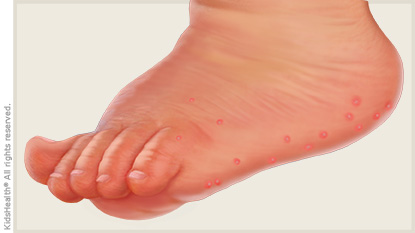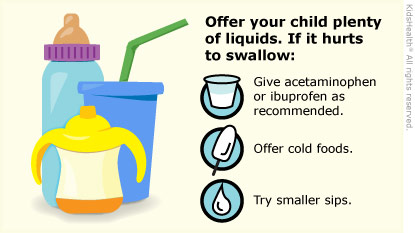Hand, Foot, and Mouth Disease
What Is Hand, Foot, and Mouth Disease (HFM)?
Hand, foot, and mouth disease (HFM) is a common viral infection that causes painful red blisters in the mouth and throat, and on the hands, feet, and diaper area. The coxsackievirus causes most HFM infections.
HFM is contagious and easily spreads through contact with unwashed hands, feces (poop), saliva (spit), mucus from the nose, or fluid from the blisters. Kids under age 7 are most at risk for HFM. Infections are common in childcare centers, preschools, schools, summer camps, and other places where kids are close together.
Besides the blisters, kids often have a fever for a few days and can get dehydrated because it hurts to swallow liquids. Symptoms usually clear up within a week to 10 days, and kids recover completely.
There’s no cure for HFM and no vaccine to prevent it, but your doctor can recommend home care to make your child more comfortable during recovery.
What Are the Signs & Symptoms of Hand, Foot, and Mouth Disease?
The blisters caused by HFM are red with a small bubble of fluid on top. They often peel, leaving an ulcer, which is a sore with a reddish base. The soles of the feet and the palms of the hands may have a rash that can look like flat red spots or red blisters.

Occasionally, there might be a pink, non-itchy rash on other parts of the body, such as the buttocks and thighs. However, some kids will have no problems other than sores in the back of the throat (called herpangina).
It can be hard for parents to tell if a child (especially a very young one) has HFM if sores are only inside the mouth or throat. Very young kids might not be able to communicate that they have a sore throat. But if a child stops eating or drinking, or wants to eat or drink less often, it’s a sign that something is wrong.
A child with HFM also might:
- have a fever, muscle aches, or other flu-like symptoms
- become irritable, fussy, or sleep more than usual
- begin drooling (due to painful swallowing)
- only want to drink cold fluids
- have belly pain, vomiting, or diarrhea
How Is HFM Treated?
You can give acetaminophen or ibuprofen if your child is achy or irritable. Never give aspirin to children or teens, as it may cause a rare but serious illness called Reye syndrome.
Cold foods like ice cream, smoothies, and popsicles also help by numbing the area, and will be a welcome treat for kids who have trouble swallowing (and even those who don’t!). Avoid hot drinks, sodas, and acidic food (citrus juice, tomato sauce, etc.) because they can make the pain worse.
Kids with blisters on their hands or feet should keep the areas clean and uncovered. Wash the skin with lukewarm soap and water, and pat dry. If a blister pops, dab on a bit of antibiotic ointment to help prevent infection and cover it with a small bandage.
Make sure your child drinks plenty of fluids to stay hydrated.
When Should I Call the Doctor?
Call your doctor if your child remains very irritable, can’t be comforted, is sluggish, or seems to be getting worse. Also call if you see signs of dehydration, like a dry or sticky mouth, sunken eyes, and peeing less than usual or fewer wet diapers.
Can Hand, Foot, and Mouth Disease (HFM) Be Prevented?
To prevent the spread of HFM, keep kids home from school and childcare while they have a fever or open blisters on the skin and in the mouth.
Hand washing is the best protection. Remind everyone in your family to wash their hands well and often, especially after using the toilet or changing a diaper, and before preparing or eating food. Shared surfaces and toys in childcare centers should be cleaned often with a disinfectant because many viruses can live on objects for a few days.

